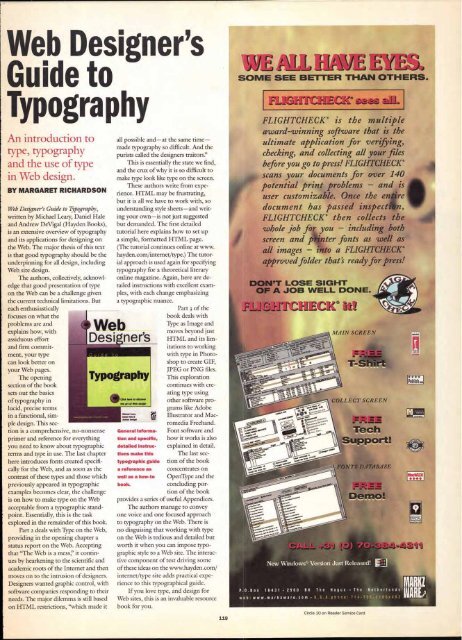aA aA aA aA aA aA aA aA aA
aA aA aA aA aA aA aA aA aA
aA aA aA aA aA aA aA aA aA
You also want an ePaper? Increase the reach of your titles
YUMPU automatically turns print PDFs into web optimized ePapers that Google loves.
Web Designer's<br />
Guide to<br />
Typography<br />
An introduction to<br />
type, typography<br />
and the use of type<br />
in Web design.<br />
BY MARGARET RICHARDSON<br />
Web Designer's Guide to Typography,<br />
written by Michael Leary, Daniel Hale<br />
and Andrew DeVigal (Hayden Books),<br />
is an extensive overview of typography<br />
and its applications for designing on<br />
the Web. The major thesis of this text<br />
is that good typography should be the<br />
underpinning for all design, including<br />
Web, site design.<br />
The authors, collectively, acknowledge<br />
that good presentation of type<br />
on the Web can be a challenge given<br />
the current technical limitations. But<br />
each enthusiastically<br />
focuses on what the<br />
problems are and<br />
explains how, with<br />
assiduous effort<br />
and firm commitment,<br />
your type<br />
can look better on<br />
your Web pages.<br />
The opening<br />
section of the book<br />
sets out the basics<br />
of typography in<br />
lucid, precise terms<br />
in a functional, simple<br />
design. This sec-<br />
tion is a comprehensive, no-nonsense<br />
primer and reference for everything<br />
you need to know about typographic<br />
terms and type in use. The last chapter<br />
here introduces fonts created specifically<br />
for the Web, and as soon as the<br />
contrast of these types and those which<br />
previously appeared in typographic<br />
examples becomes clear, the challenge<br />
is on how to make type on the Web<br />
acceptable from a typographic standpoint.<br />
Essentially, this is the task<br />
explored in the remainder of this book.<br />
Part 2 deals with Type on the Web,<br />
providing in the opening chapter a<br />
status report on the Web. Accepting<br />
that "The Web is a mess?' it continues<br />
by hearkening to the scientific and<br />
academic roots of the Internet and then<br />
moves on to the intrusion of designers.<br />
Designers wanted graphic control, with<br />
software companies responding to their<br />
needs. The major dilemma is still based<br />
on HTML restrictions, "which made it<br />
all possible and—at the same time—<br />
made typography so difficult. And the<br />
purists called the designers traitors?'<br />
This is essentially the state we find,<br />
and the crux of why it is so difficult to<br />
make type look like type on the screen.<br />
These authors write from experience.<br />
HTML may be frustrating,<br />
but it is all we have to work with, so<br />
understanding style sheets—and writing<br />
your own—is not just suggested<br />
but demanded. The first detailed<br />
tutorial here explains how to set up<br />
a simple, formatted HTML page.<br />
(The tutorial continues online at www.<br />
hayden.com/internet/type.) The tutorial<br />
approach is used again for specifying<br />
typography for a theoretical literary<br />
online magazine Again, here are detailed<br />
instructions with excellent examples,<br />
with each change emphasizing<br />
a typographic nuance.<br />
Part 3 of the<br />
book deals with<br />
We<br />
Des b<br />
i ner's<br />
Typography<br />
akk ben to discover<br />
the art of Web design<br />
woe.<br />
Type as Image and<br />
moves beyond just<br />
HTML and its limitations<br />
to working<br />
with type in Photoshop<br />
to create GIF,<br />
JPEG or PNG files.<br />
This exploration<br />
continues with creating<br />
type using<br />
other software programs<br />
like Adobe<br />
Illustrator and Macromedia<br />
Freehand.<br />
General informa- Font software and<br />
tion and specific, how it works is also<br />
detailed instruc- explained in detail.<br />
tions make this The last sec-<br />
typographic guide tion of the book<br />
a reference as concentrates on<br />
well as a how-to OpenType and the<br />
book. concluding por-<br />
tion of the book<br />
provides a series of useful Appendices.<br />
The authors manage to convey<br />
one voice and one focused approach<br />
to typography on the Web. There is<br />
no disguising that working with type<br />
on the Web is tedious and detailed but<br />
worth it when you can impose typo-<br />
graphic style to a Web site. The interactive<br />
component of test driving some<br />
of these ideas on the www.hayden.com/<br />
internet/type site adds practical experience<br />
to this typographical guide.<br />
If you love type, and design for<br />
Web sites, this is an invaluable resource<br />
book for you.<br />
119<br />
WE Ni ME<br />
SOME SEE BETTER THAN OTHERS.<br />
FLIGHTCHECK® is the multiple<br />
award-winning software that is the<br />
ultimate application for verifying,<br />
checking, and collecting all your files<br />
before you go to press! FLIGHTCHECK®<br />
scans your documents for over 140<br />
potential print problems — and is<br />
user customizable. Once the en re<br />
document has passed inspect n<br />
FLIGHTCHECK® then collects the<br />
whole job for you — including both<br />
screen and Anter fonts as well as<br />
all images — into a FLIGHTCHECK®<br />
approved folder that's ready for press!<br />
DON'T LOSE SIGHT<br />
OF A JOB WELL DONE.<br />
1,.rj r<br />
r P<br />
r,®<br />
COLLECT SCREEN<br />
Tech<br />
upport!<br />
FONTS DATABASE<br />
New Windows Version Just Released!<br />
1..4<br />
i****<br />
Publish,.<br />
1111 "<br />
MERE<br />
P.O.Box 16431 - 2500 BK The Hague - The Netherlands WARE,<br />
web: www.markzware.com -ii.S,A.phone: 714
















